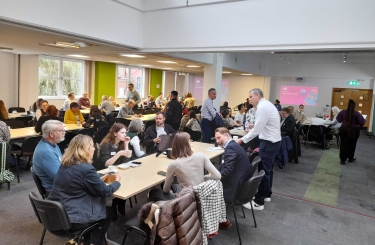Related


As part of our ongoing learning focus on what it takes to fund and drive systemic change, we recently spoke to Letícia Ishibashi, Head of Programmes (Migration) at Paul Hamlyn Foundation about the new vision for their Migration Fund, which envisions a radical alternative to the existing hostile immigration system – one where “everyone is free to move and no one is forced to move”.
We spoke with Letícia about how Paul Hamlyn developed this vision together with those working in migration and related fields, how their funding processes changed as a result and where she sees the Foundation’s role in the fight for an immigration system rooted in justice, solidarity and freedom.
Paul Hamlyn Foundation established a dedicated Migration Fund in 2015 and since then we have seen a few different iterations of it that aimed to address the political context and needs of the field. More recently, the Foundation’s commitment to become an anti-racist funder has required us to think about what this means for our Fund in practice.
One thing that became clear was that we needed to define some of the terms we used often like ‘systems change’, ‘social justice’, ‘anti-racism’, ‘fairness and justice’. We tend to assume everyone ascribes the same meaning to these terms when that’s often not the case. If we don’t define what these concepts mean to us and don’t have a clear vision of what we are trying to build, it becomes impossible to put a strategy in place because then everything is up for grabs.
While we knew we had to define these terms and clearer vision for the Fund, we didn’t feel comfortable doing so on our own. We felt that we needed to practice our commitment to anti-racism by creating space for these things to be defined by the people that are going to be affected by our work.
So, we organised exploratory sessions across the UK, bringing together organisations we fund and those we don’t fund to explore how change happens, their local context, what is needed from funders like us and to ask ‘if we were to achieve everything that we want to achieve for migrants, what does that look like?’.
We felt it was important to create a space for migrants, refugees and those working alongside them to define what their vision for the future is. These reflective spaces are quite rare, as those working towards migrant justice spend so much time firefighting and responding to anti-migrant legislation, policies, and narratives. We wanted to create a space that allowed them to move away from this reactive practice, to be able to think together about what the movement is for, not just what it is against.
People didn't want to just make the immigration system fairer. They actually felt like the immigration system is unfair in itself.
One thing that worked really well was that we asked everyone to come into the space representing themselves and not the institution or organisation they worked for. This seemed to encourage people to share their own thoughts as opposed to their organisation’s position, and to be more critical and honest about what they think is working, what needs to change and what needs more investment across the movement.
We were surprised that the analysis and insight being shared were a lot more radical and exciting than what applicants usually say to us in funding applications. When we asked about why they thought that is, many mentioned they thought funders would be too scared to fund something that fights for freedom of movement for everyone so explicitly, where everyone has the same right and access to housing and welfare, for example. It was a real eye opener for us – it was clear that if we want to attract applicants that are thinking about solutions to the big and complex challenges we are facing, funders need to be more transparent about their own political analysis and vision.
After we finished the consultation, we invited feedback on our new vision, criteria, and application process. We invited some people who had been involved in the consultation and others who were seeing this work for the first time. We asked them to look at everything from the language we were using to the questions we were proposing for the application and assessment processes. We then incorporated their feedback and had a final online feedback process to check that they were happy with the changes we’d made.
Needless to say, everyone who participated in this process was compensated for their time.
One of the significant changes we introduced following the consultation was to focus our application process on both what applicants are trying to achieve, and how they work. The latter was a response to feedback we’d received about the need for funders to pay more attention to the dynamics and practice within the movement.
This directly related to our commitment to practice anti-racism. It required us to think more carefully about the extent to which our funding decisions are supporting organisations that are working in oppressive and harmful ways; or those whose approach helps to perpetuate the systems we say we are working to dismantle. Following this feedback, it became really important to us to incorporate questions about organisational practice into our grant-making as it was a significant area of concern during our consultation.
One question put to us in the feedback process was ‘where is your question about anti-racism?’. The application form had a question about anti-oppressive practice, so we had assumed applicants would include their anti-racism work in response to that question. But the feedback highlighted that we needed to be more explicit about wanting to know about applicants’ understanding of anti-racism and how anti-racist practice is embedded in their work. So, we added this question to the form and also kept the one about anti-oppressive practice. Now that the new process is live, we’re really glad we incorporated this feedback, as it has provided us with a lot more information and nuance on what organisations are doing to tackle systemic racism.
From the start, one thing our team was really concerned about was that we didn’t want to become a ‘morality police’. We don’t have all the answers and are also strengthening our own anti-racist practice. To respond to this, we felt it was important to develop a different way to make decisions that reflected the more consultative and transparent approach we had taken during the consultation.
For the first time, we’ve introduced an external advisory group made up of six people, all of whom have a strong understanding of anti-racist and anti-oppressive practice, have lived and learned experience of the issues we fund, and bring more knowledge of the different regional contexts across the UK. They’ve started working with us to review applications and make decisions about who we’re shortlisting and funding.
Yes, I think the consultation helped clarify what we mean by ‘systemic change’. If we accept that the immigration system we have is unfair, unjust, and harmful; that it’s a product of imperialism, colonialism and racism. ‘Systems change’ in this context means dismantling the current system and proposing alternatives that allow everyone to decide where they want to live, and to have full rights where they chose to be. Our role as a ‘systems change’ funder is to support the people and organisations that are designing and trialling these alternatives so that we are able to replace the unjust system we have with something that is built on the values of justice, solidarity and freedom for all.
We can't just be bystanders in social movements and think we can just give out the money and that’s it. We should be putting a lot of work in understanding systems of oppression, in dismantling those within our organisations.
Like most funders, we were relying too heavily on a couple approaches to change. We tended to disproportionately fund ‘inside-game’ approaches, like research, lobbying Parliament, etc. That is really important work but it’s not everything. We weren’t funding enough work that was about building power within communities, allowing them to organise and campaign for the things they care about. Our aim now is to support a diversity of approaches to creating change, paying special attention to the approaches we have underfunded in the past.
More traditional M&E systems create a sense that if you have a policy goal, you plan and strategise well for it, you will reach that goal. But, in reality, even if you do everything perfectly and you’ve planned everything out and done your risk assessments, you still might not achieve that original policy goal for a range of reasons. That doesn’t mean you haven’t been successful. There will be learning along the way, about what tactics work, the ones that don’t, and what we can build on.
So we have moved away from “tell us what outcomes you want to achieve” to “what do you want to learn”. We ask organisations to propose 3-5 learning questions they want to explore during the lifetime of the grant, and there is no expectation they need to have a clear answer by the end of the grant cycle. The aim is to create space for deeper reflection, which can be supported through our ‘grants plus’ offer.
The intention is to enable organisations to explore questions about their work that aren’t usually resourced by funders.
We’re not directive, so applicants can decide whatever they want to focus on. Some choose to explore how to strengthen their anti-racist practice; others are focused on diversifying their funding; some want to better embed lived experience in their work; a few have more existential questions about the effectiveness of their model and whether they need to change. It’s really broad – the intention is to enable organisations to explore questions about their work that aren’t usually resourced by funders. We’re trialling this for the first time, so we don’t yet know how it’ll go but we’ve been receiving really positive feedback from applicants so far.
I also want to stress that when we’re talking about ‘systems change’, we’re not just saying that we’re sitting down at home dreaming about how nice it would be if things looked like this. Everything we’re funding is actual practice – it’s about changing the way we behave, our mindset and unlearning oppressive practice. So yes, it’s important to have a vision but there are so many things in that vision that require us to change the way we practice things right now, what we propose as solutions, where we draw the line between where we compromise and where we become co-opted by the current system.
When we’re talking about ‘systems change’, we’re not just saying that we’re sitting down at home dreaming about how nice it would be if things looked like this. Everything we’re funding is actual practice.
This connection between vision and practice is not always clear because for many funders these goals can seem ‘dreamy’, abstract and unreachable, but we have to remind ourselves that most successful and transformational social justice movements started with visions that at the time felt unattainable. There is so much we can do now to make these transformative visions more accessible to the wider public, to support ourselves and organisations we fund to embed anti-racist practice, and channels resources to those who are designing alternatives that are not constrained by the status quo.
Letícia has written more about the shared vision for Paul Hamlyn Foundation’s Migration Fund here. If you are interested in what funders can do in this area, please have a read of London Funders’ ‘A strategy for funding immigration advice in London’ here.

